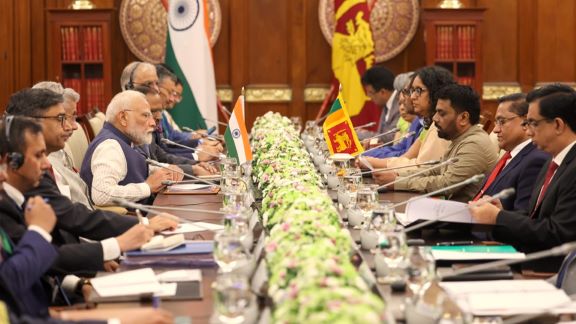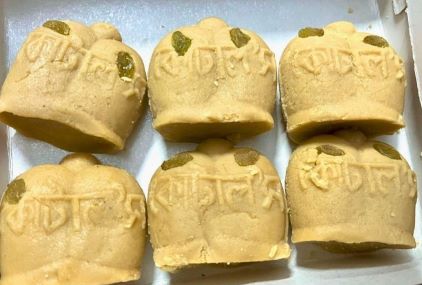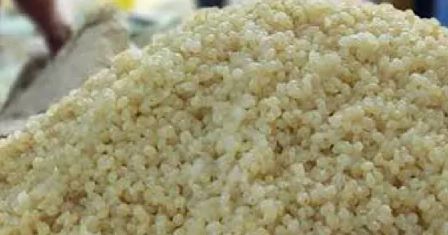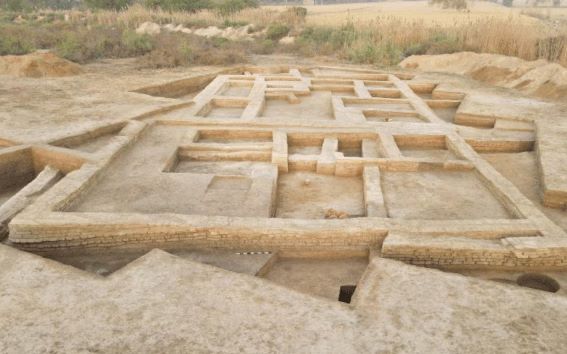This is the current affairs of 9 April 2025. Here are questions and answers of daily current affairs for better preparation of competitive exams for government jobs.
PDF Download: Click here
1. With which neighbouring country did India sign an electricity grid inter-connectivity agreement through submarine cable?
a. Sri Lanka
b. Maldives
c. Bhutan
d. China
Answer: a. Sri Lanka

– Indian Prime Minister Narendra Modi visited Sri Lanka from April 4 to 6, 2025.
– During this visit, seven agreements (MoUs) were signed between the two countries.
– One of these is the “HVDC (High Voltage Direct Current) Interconnection Project for the import/export of electricity between the two countries.”
What did PM Modi say:
– He stated that the grid interconnectivity agreement between the two countries will open up options for electricity exports to Sri Lanka.
– PM Modi mentioned that Sri Lanka holds a “special place” in India’s Neighbourhood First policy and vision for the ‘Ocean’ (This vision aims to promote economic development, regional security, and sustainable development).
Electric Cable in the Sea:
– This project will connect India and Sri Lanka through an electricity connection.
– It is significant for India’s energy security in the region and for potential ASEAN electric connections.
– It will also increase India’s geopolitical influence.
– A similar project is underway between Andaman and Paradip (Odisha) for a subsea power link.
– A 1150 km long cable is planned to be laid between Andaman and Paradip.
What is its international goal?
– Under the OSOWOG (One Sun, One World, One Grid) framework, the aim is to establish international energy trade relations with ASEAN countries, especially with Singapore.
One Sun, One World, One Grid (OSOWOG) Project:
– The goal is to maintain the continuous production capacity of solar power plants, particularly after sunset.
It is planned to be implemented in three phases:
– Phase 1: Grid connection between Asia and West Asian countries.
– Phase 2: Connecting African, South Asian, and East Asian countries.
– Phase 3: Establishing a global grid to connect all countries with renewable energy.
Sri Lanka
President – Anura Kumara Dissanayake
Prime Minister – Harini Amarasuriya
Capital – Sri Jayewardenepura Kotte (legislative) and Colombo (executive and judicial)
Currency – Sri Lankan Rupee
Source : Ministry of External Affairs
—————
2. How many agreements were signed during PM Modi’s visit to Sri Lanka in April 2025?
a. 1
b. 5
c. 7
d. 10
Answer: c. 7

– Indian Prime Minister Narendra Modi visited Sri Lanka from 4 to 6 April 2025.
Agreement between India – Sri Lanka
– HVDC interconnection project between the two countries for import / export of electricity
– Cooperation on digital transformation at the population level
– Cooperation in developing Trincomalee as an energy hub (United Arab Emirates (UAE) is also a partner in this agreement. It is also investing.)
– Defense cooperation
– Multi-sectoral grant assistance for the Eastern Province
– Cooperation in the field of health and medicine
– Pharmacopoeia cooperation between the Indian Pharmacopoeia Commission and the National Drug Regulatory Authority, Sri Lanka
Inauguration and Foundation Laying of Projects:
1. Inauguration of the upgraded railway track on the Mahaw-Omanthai railway line.
2. Launch of the signaling system construction for the Mahaw-Anuradhapura railway line.
3. Groundbreaking ceremony of the Sampur Solar Energy Project (Virtual).
4. Inauguration of the temperature-controlled agricultural warehouse in Dambulla (Virtual).
5. Supply of solar rooftop systems to 5000 religious institutions in Sri Lanka (Virtual).
What Sri Lanka said:
– Sri Lankan President Anura Kumara Dissanayake emphasized on Saturday that his government “will not allow the use of its land in any way that is harmful to India’s security and regional stability.”
– This statement is believed to be in the context of China.
What PM Modi said:
– Modi stated, “The Sampur solar energy plant will help in Sri Lanka’s energy security. The agreements made for the construction of the multi-product pipeline and the development of Trincomalee as an energy hub will benefit all the people of Sri Lanka.”
Source : Indian Express | Ministry of External Affairs
—————-
3. The world’s oldest living tree “Jaya Sri Maha Bodhi Tree” is located in which country and its city, where PM Modi visited in April 2025?
a. In Anuradhapura, Sri Lanka
b. In Bangkok, Thailand
c. In Gaya, India
d. In Osaka, Japan
Answer: a. In Anuradhapura, Sri Lanka

– On April 6, 2025, PM Narendra Modi visited the historic city of Anuradhapura in Sri Lanka and toured the ‘Jaya Sri Maha Bodhi Temple.’ This temple houses the “Jaya Sri Maha Bodhi Tree.”
What is the Jaya Sri Maha Bodhi Tree?
– The Jaya Sri Maha Bodhi Tree is considered the oldest living plant in the world.
– It is believed that this tree grew from a branch of the “Bodhi” tree (Ficus Religiosa, known as Peepal in Hindi) located in Bodh Gaya (Bihar), under which Gautama Buddha attained enlightenment.
– This branch was brought to Sri Lanka by Ashoka the Great’s daughter, the Buddhist nun Sanghamitra.
– The arrival of the tree in Sri Lanka is still celebrated today as “Uduvapa Poya,” an annual festival observed on the full moon night in December.
– Along with other Buddhist temples in the ancient city of Anuradhapura, this tree remains a major pilgrimage site for Buddhists.
How has the Jaya Sri Maha Bodhi Tree survived for so long?
– The Peepal tree can regenerate from its roots and seeds, and with proper care, its lifespan can be prolonged.
– However, this tree has not been untouched by attacks.
– In 1929, a person attempted to cut it down brutally.
– In 1985, when LTTE (Liberation Tigers of Tamil Eelam) militants created havoc in Anuradhapura, 146 people around the tree were shot dead.
What is said about the Mahabodhi Tree in Gaya?
– The tree located in Gaya, Bihar, under which Lord Buddha meditated, was destroyed.
– (According to some legends, it was destroyed by one of Ashoka’s wives, Tishyarakshita.)
– However, it is believed that the current Peepal tree at that site grew from the germplasm (genetic material) of the original tree.
Why did Sanghamitra travel to Sri Lanka?
– It is believed that during Emperor Ashoka’s reign, the Third Buddhist Council was held, where it was decided to send missionaries to various regions for the propagation of Buddhism.
– Missions were sent to Gandhara, Kashmir, South India, some Greek states, and Sri Lanka.
– The mission to Sri Lanka was led by Prince Mahendra, or Ashoka’s son Mahinda, and it was very successful.
– Mahinda met King Devanampiya Tissa, whose capital was Anuradhapura, and converted him to Buddhism.
– When several royal women expressed a desire to join the Buddhist monastic order, Mahinda called his sister, Sanghamitra, and sent her to provide them with initiation.
– Both Mahinda and Sanghamitra spent the rest of their lives in Anuradhapura.
Anuradhapura – A UNESCO World Heritage Site:
– Anuradhapura was the political and religious capital of Ceylon (Sri Lanka), flourishing for 1,300 years before being abandoned after an invasion in 993 AD.
– According to UNESCO’s website: “This magnificent site, hidden for many years in dense jungles, with its palaces, monasteries, and monuments, is now accessible again.”
– The invasion in 993 AD was carried out by the Chola Empire from South India.
Sri Lanka:
– Capital: Sri Jayawardenepura Kotte and Colombo
– Prime Minister: Harini Amarasuriya
– President: Ranil Wickremesinghe
– Population: 22 million (2023)
– Languages: Sinhala, Tamil
– Currency: Sri Lankan Rupee
– Neighboring Countries: India and the Maldives
Source : Indian Express
—————-
4. When is Central Reserve Police Force (CRPF) Valour Day celebrated?
a. 10 April
b. 9 April
c. 8 April
d. 7 April
Answer: b. 9 April
– On April 9, 1965, a CRPF (Central Reserve Police Force) contingent defeated the Pakistani army at Sardar Post in Kutch, Gujarat.
– The CRPF killed 34 Pakistani soldiers and captured four alive.
– In this battle, 6 CRPF personnel were martyred.
– The CRPF is India’s largest Central Armed Police Force.
– It operates under the Ministry of Home Affairs, Government of India.
CRPF Headquarters: New Delhi
– Formation: July 27, 1939
– Motto: Service and Loyalty.
—————
5. Which state’s sweet Nolen Gurer Sandesh has received the Geographical Indication (GI) tag?
a. West Bengal
b. Bihar
c. Uttar Pradesh
d. Gujarat
Answer: a. West Bengal

– Nolen Gurer Sandesh is a popular Bengali winter sweet from West Bengal, made from chhena (cottage cheese from curdled milk) and nolen gur (date palm jaggery).
– The jaggery gives the sandesh (a type of sweet) a rich, caramel-like flavor and a warm golden color.
– This same jaggery is used in “Joynagar Moa,” another traditional sweet that received a GI tag a few years ago.
Capital: Kolkata
– Chief Minister: Mamata Banerjee
– Governor: Dr. C. V. Ananda Bose
Source : NDTV
—————
6. Which state’s “Baruipur Guava” has got the Geographical Indication (GI) tag?
a. Bihar
b. West Bengal
c. Uttar Pradesh
d. Gujarat
Answer: b. West Bengal

– This is a special type of guava that is either seedless or has very few seeds.
– It is delicious and suitable for commercial cultivation.
– It grows easily in any environment and can be grown in home tubs or on rooftops as well.
Source : NDTV
—————
7. The white ‘Bonde’ of Kamarpukur of which state has got the Geographical Indication (GI) tag?
a. Madhya Pradesh
b. Rajasthan
c. West Bengal
d. Gujarat
Answer: c. West Bengal

– This is a sweet that originates from Kamarpukur in Bengal. The main ingredients used for this sweet are chhena (a dairy product made from curdled milk), ghee, and sugar.
– Its white texture, delicate flavor, and balanced sweetness give it a delightful taste.
Source : NDTV
—————
8. Which state’s sweet “Chhanabora” has got the Geographical Indication (GI) tag?
a. West Bengal
b. Rajasthan
c. Madhya Pradesh
d. Gujarat
Answer: a. West Bengal

– “Chanabora” is a famous sweet from Murshidabad in Bengal.
– This sweet has been popular since the time of the Nawabs and is loved in Bengal.
– It was traditionally served in the Nawab’s court to entertain guests.
Source : NDTV
—————
9. Which state’s ‘Motichoor Laddu’ has got the Geographical Indication (GI) tag?
a. West Bengal
b. Rajasthan
c. Madhya Pradesh
d. Gujarat
Answer: a. West Bengal

– Motichoor Laddu is found in Vishnupur, located in the Bankura district of Bengal.
– It is a legacy of the Mall kings of Vishnupur, as the kings ordered the creation of a special modak for their family deity, Radha Govinda.
– As a result, a sweet dish was made with tiny pearls of boondi that looked shiny, and it came to be called Motichoor Laddu.
– It is made by mixing ghee with besan (gram flour) and then combining it with sugar syrup.
Source : NDTV
—————
10. Which state’s ‘Radhunipagal Rice’ has got the Geographical Indication (GI) tag?
a. Gujarat
b. Rajasthan
c. Madhya Pradesh
d. West Bengal
Answer: d. West Bengal
– Earlier, a similarly named rice, “Ramdhuni Pagal Rice,” was awarded the GI (Geographical Indication) tag in January 2024.
Radhunipagal Rice
– Radhunipagal Rice is a variety of small-grained, fragrant, non-basmati rice that originates from West Bengal, known for its sweet taste and strong aroma. It is traditionally grown in the Rahr and Ganga plains.
– It is used to prepare dishes like “Payesh” (rice pudding) and “Pitha” (rice cakes).
– Rice cultivation is traditionally done in the southern region of West Bengal, particularly in the districts of Birbhum, Dinajpur, Bardhaman, Bankura, and Hooghly.
Ramdhuni Pagal Rice
– Ramdhuni Pagal Rice is cultivated in the Birbhum, Purba Bardhaman, Paschim Bardhaman, Bankura, and Hooghly districts.
– This rice is made from the stalks of the rice plant. To make it, the stalks are dried, then ground into flour. This flour is mixed with water to prepare a batter, which is then cooked on a tawa (flat pan) in a pan. This dish is known as Ramdhuni Pagal Rice.
—————
11. Nistari silk thread of which state has got the Geographical Indication (GI) tag?
a. Gujarat
b. Rajasthan
c. West Bengal
d. Madhya Pradesh
Answer: c. West Bengal
– This silk thread is produced in the Malda district of West Bengal.
– It is known for its excellent texture, durability, and intricate traditional weaving techniques.
– Nastari silk thread is very shiny in appearance and soft to the touch, and it has global demand.
Source : NDTV
—————
12. Amalsad Chikoo of Navsari in which state got Geographical Indication (GI tag)?
a. Rajasthan
b. Gujarat
c. Madhya Pradesh
d. Uttar Pradesh
Answer: b. Gujarat
– On April 4, 2025, it was awarded the GI tag.
– Amalsad Chikoo is named after the village ‘Amalsad’ in the Navsari district of Gujarat.
– This chikoo has been given the GI tag due to its “unique characteristics and deep connection with the region.”
– After Gir Kesar mango and Kachhi Kharek (dates), Amalsad Chikoo is the third fruit from Gujarat to receive the GI tag.
– Gujarat alone contributes 98% of India’s chikoo exports, and Navsari district is the largest producer of chikoo.
– Major importers of Indian chikoo include the UAE, UK, and Bahrain.
– Capital: Gandhinagar
– Chief Minister: Bhupendrabhai Patel
– Governor: Acharya Devvrat
– Population: 60.4 million (2011)
– Language: Gujarati
– State Dance: Garba
—————
13. Which state government declared two Harappan civilization sites located in Tighrana and Mitathal villages as protected archaeological sites and monuments?
a. Rajasthan
b. Haryana
c. Madhya Pradesh
d. Gujarat
Answer: b. Haryana

– The Haryana government has declared two sites from the Harappan civilization, more than 4,400 years old, in Bhiwani district as protected monuments and archaeological sites.
– These two sites are located in the villages of Tighrana and Mithathal in Bhiwani district.
– According to the notification issued by Haryana’s Principal Secretary (Heritage & Tourism), Kala Ramachandran, on March 13, 2025, more than 10 acres of land in Mithathal will be preserved.
– The notification was issued under the Haryana Ancient and Historical Monuments and Archaeological Sites and Remains Act, 1964, by the Department of Heritage & Tourism, Haryana.
– According to the notification, the archaeological excavations done in Mithathal in 1968 revealed the culture of the Chalcolithic Age of the India-Ganga region during the third and second millennium BCE.
– This site first came to light in 1913 when a hoard of coins of one of the greatest rulers of the Gupta dynasty, Samudragupta, was found.
– Between 1965 and 1968, discoveries of beads and copper tools were made at this site, revealing proto-historical materials.
– Officials say that the excavations at Mithathal provide evidence of Harappan traditions in city planning, architecture, and arts and crafts.
– The pottery found was well-fired, strong red pottery painted in black with designs like peepal leaves, fish scales, and other geometric patterns.
– Objects found at this site include pearls, bangles, terracotta, stones, shells, copper, ivory, and bone items.
– The notification for the Tighrana village site mentions that post-Harappan remains in this region provide insights into the development of human settlements.
– The earliest inhabitants of this region were copper-stone agricultural communities who settled here around 2400 BCE.
– These early settlers (known as Sothians) lived in small mud-brick houses with thatched roofs in places like Chang, Mithathal, Tighrana, etc.
– Some of their settlements may have been fortified, with each having 50 to 100 houses.
– They practiced agriculture, raised cattle such as cows, oxen, and goats, and used two-tone pottery made from clay, painted with black and white designs.
– They used copper, bronze, and stone tools, as evidenced by the large number of such tools found.
– The discovery of remains from pre-Siswal, pre-Harappan, and post-Harappan settlements in Tighrana is an important archaeological find.
– The presence of beads and green carnelian bangles indicates the production of beads and jewelry.
Capital: Chandigarh
Chief Minister: Manohar Lal Khattar
Governor: Bandaru Dattatreya
Population: 25.3 million (2011)
State Dance: Phag, Jhoomar, Loor, Daff, Dhamal, Gugga, and Khoriya
Language: Haryanvi
Source : Indian Express





